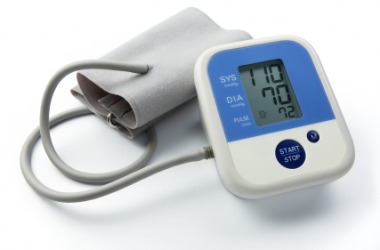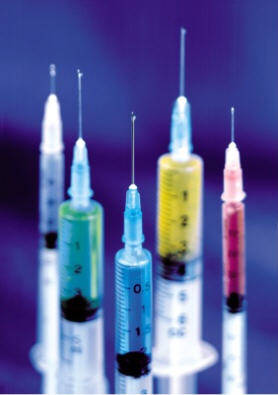What do all those test at your regular check-up really mean?
 Every year or so, you make an appointment to be poked and prodded, stuck with needles, and handed a cup much smaller than your usual target in which to pee. Somewhere between dressing up in the backless gown and handing over your bodily fluids, you might wonder, Do I really need this? Routine physicals are not only important for early detection of disease, but also for establishing a doctor-patient relationship. You don’t necessarily need an annual physical – the official recommendation is every three to five years – but once a year is best after age 40. Here are the tests to get at that initial check-up.
Every year or so, you make an appointment to be poked and prodded, stuck with needles, and handed a cup much smaller than your usual target in which to pee. Somewhere between dressing up in the backless gown and handing over your bodily fluids, you might wonder, Do I really need this? Routine physicals are not only important for early detection of disease, but also for establishing a doctor-patient relationship. You don’t necessarily need an annual physical – the official recommendation is every three to five years – but once a year is best after age 40. Here are the tests to get at that initial check-up.
TEST Blood pressure
WHAT IT IS Measures the force applied to artery walls as your heart pumps blood throughout your body. The technician inflates a cuff around your upper arm then deflates it slightly; listening with a stethoscope, she records the number on the dial when she first hears blood pulsing and the number when she can no longer hear it.
WHEN TO GET IT At least every two years, or every year if you have high blood pressure
NORMAL RANGE First (systolic) number: under 120. Second (diastolic) number: under 80. (In other words, it should be less than “120 over 80”)

WHAT AN ABNORMAL RESULT MEANS If consistent (not just one time on one visit), it could indicate heart disease, a neurological or kidney condition, preeclampsia if you’re pregnant, or stress. Your doctor may run more tests such as a blood test of electrolytes, sodium, and potassium; and EKG; and/or an echocardiogram. If they’re all normal, high BP most likely points to a hereditary higher risk for heart disease and stroke, which can be treated by cutting salt and alcohol intake, losing weight, and taking medication such as alpha and beta blockers, as well as ACE inhibitors and diuretics.
TEST Urinalysis
WHAT IT IS A sample of your urine is assessed with the naked eye, under a microscope, and with chemical tests to look for abnormalities.
WHEN TO GET IT At your regular physical
NORMAL RANGE The sample should be anywhere from colorless to dark yellow, and not contain much or any red blood cells and proteins.
WHAT AN ABNORMAL RESULT MEANS The test can pick up a range of issues from an asymptomatic urinary infection to the first signs of kidney or bladder cancer. Further tests can pinpoint the problem.
TEST 25-hydroxy vitamin D
WHAT IT IS After not eating for 4 hours, your blood is drawn to determine body levels of vitamin D.
WHEN TO GET IT Periodically, or at your regular physical
NORMAL RANGE 30.0 to 74.0 nano-grams per milliliter (ng/mL)
WHAT AN ABNORMAL RESULT MEANS Low levels indicate deficiency, which is becoming more common as people cover up to prevent skin cancer (vitamin D is manufactured by the body in response to sun exposure) and has been linked with greater risk of heart disease and cancer, as well as weakening of the bones.
TEST Cholesterol and triglycerides
WHAT IT IS A blood test to determine the amount of cholesterol (a waxlike substance) and triglycerides (a type of fat) in your arteries. For the most accurate results, eat or drink nothing but water for 9 to 12 hours beforehand.
WHEN TO GET IT At least every five years, starting at age 45; sooner if you have a family history of heart attack or stroke
NORMAL RANGE Total cholesterol: under 200 milligrams per deciliter (mg/dL). HDL (“good”) cholesterol: over 40 mg/dL. LDL (“bad”) cholesterol: under 100 mg/dL.
WHAT AN ABNORMAL RESULT MEANS Triglycerides: under 150 mg/dL low HDL or high LDL or high triglycerides mean you’re at greater risk for heart disease and stroke. Try to improve your scores by eating less saturated and trans fat and more fiber, exercising, losing weight, and quitting smoking. If that doesn’t work, your doctor may prescribe medication, such as statin drugs.
TEST Thyroid stimulating hormone
WHAT IT IS A blood test measuring your level of TSH, a pituitary gland hormone that signals your thyroid gland to produce two other hormones called T3 and T4
WHEN TO GET IT Every five years starting at age 35 for women (who are more vulnerable than men)
NORMAL RANGE 0.4 to 4.0 milli-international units per liter (mIU/L)

WHAT AN ABNORMAL RESULT MEANS You may have hypothyroidism ( a high TSH number indicating underactive thyroid) or hyperthyroidism (a low TSH number indicating overactive thyroid). They can cause symptoms such as fatigue, weight gain, or weight loss, and raise your risk for heart disease. The first step in treatment is typically mediation, including synthetic hormones and methimozole. If you have hyperthyroidism, your doctor may run more tests to determine the cause, which is more complex than with hypothyroidism.
TEST Blood glucose
WHAT IT IS After you’ve fasted for at least eight hours, blood is drawn to measure the amount of glucose (or sugar) it contains.
WHEN TO GET IT Every three years starting at age 45; sooner and more frequently if you’re overweight, have a family history of diabetes, or have other risk factors
NORMAL RANGE Under 100 mg/dL
WHAT AN ABNORMAL RESULT MEANS Your doctor will repeat the test to confirm the results. If still high, you may be diagnosed with diabetes or pre-diabetes, which can be managed with medication and changes to your diet to control blood sugar.
TEST Complete blood count (or CBC)
WHAT IT IS A blood test that measures the number and proportion of the various components of your blood
WHEN TO GET IT At least every five years
NORMAL RANGE FOR RED BLOOD CELLS 3.90 to 5.03 trillion cells/L. Hemoglobin: 12.0 to 15.5 g/dL. Hematocrit: 34.9 to 44.5 percent. White blood cells: 3.5 to 10.5 billion cells/L. Platelets: 150 to 450 billion/L
WHAT AN ABNORMAL RESULT MEANS If your numbers are significantly outside the normal range, it could indicate an infection, anemia, or a more serious condition, like leukemia. Your doctor may order more tests, consider other health factors and test results to come up with a diagnosis, or refer you to a specialist.

